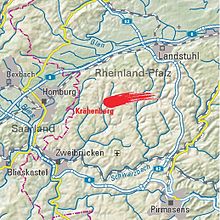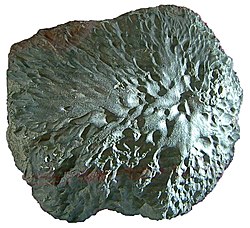Krähenberg (meteorite)
| Krähenberg (meteorite) | |
|---|---|
| Official meteorite name | Crows Mountain |
| Locality | District of Südwestpfalz ( Rhineland-Palatinate ) |
| Fall time | May 5, 1869, 6:32 p.m. |
| description | Chondrite (LL5); 14.75 from the original 15.75 kg; about 30 × 18 cm; Density: 3.449 g / cm³ |
| origin | Asteroid (25143) Itokawa ? |
| collection | Original in the Palatinate Museum for Natural History (Bad Dürkheim); Replicas in the GEOSKOP Urweltmuseum (Thallichtenberg) and in the village community center in Krähenberg |
| authenticity | for sure |
| Coordinates | 49 ° 19 ′ 37.7 " N , 7 ° 27 ′ 56.8" E |

The Krähenberg meteorite , also known as the Krähenberger meteorite or the Krähenberger for short , is a meteoritic solid of cosmic origin that fell in the field area of the local community of Krähenberg on Sickinger Höhe in what is now the district of Southwest Palatinate ( Rhineland-Palatinate ) in 1869. It is one of the more than 50 meteorites in Germany that have so far been officially recognized.
According to studies in the second half of the 20th century is a 4.7 billion year old stone meteorites , which because of trapped silicate -Schmelzkügelchen, the chondrules to the chondrites is expected. According to the iron content in olivine and its texture , it is classified as LL5 chondrite.
The List of Meteorites contains a compilation of articles on individual meteorites that are interesting for scientific, historical, or other reasons .
Geographical location
The point of impact of the meteorite is around 280 m above sea level. NHN about 300 m south of the former development boundary of Krähenberg. The Ohmbach flows past just to the east , a left tributary of the Auerbach , which is also called Wiesbach on the upper and middle reaches.
history
Visual and acoustic perception
The meteorite struck a meadow on May 5, 1869 at around 6:32 p.m. A “loud roar” is said to have been heard and immediately before the object in the sky shone as a so-called fireball in an extremely “brilliant” white.
Contemporary witnesses have made several observations of the meteorite crash. According to the farmer Heinrich Lauer, who was with another man and a little girl in a field near the impact site, the meteorite had penetrated two feet (about 60 cm) into the ground. The still warm object was excavated by Lauer and his companion.
The natural scientist Georg von Neumayer , who comes from the Palatinate , noted that the event was so loud that the assumption arose in the immediate vicinity that “the railway had jumped into the air near Homburg and let out steam from above.” The impact was supposed to be heard not only in the West Palatinate (e.g. in Kusel , 23 km away), but also as far as the Front and South Palatinate ; called Gleisweiler (45 km, near Landau ) and Speyer (70 km). The event was even registered in Wiesbaden (100 km).
Handling the object
The meteorite was on display in the Krähenberg schoolhouse for about ten days. Then it was taken to the Palatinate History Museum in Speyer, which bought it in the summer of 1869; The municipality and the property owner each received 100 guilders . For more than twenty years, the royal Bavarian state government responsible at the time tried again and again to incorporate the find into the Mineralogical State Collection in Munich ; on November 18, 1891, however, the Palatinate District Councilor , whose successor body is the District Association of the Palatinate , finally rejected the request. Today the original stone is in the Historical Museum of the Palatinate in Speyer , replicas in the Palatinate Museum for Natural History and in the Urweltmuseum GEOSKOP at Lichtenberg Castle . Small pieces - total weight less than 40 grams - were given to institutes and museums in Munich, London and Vienna for scientific purposes between 1899 and 1906 ; therefore the object is slightly lighter than initially. Another replica of colored plaster of the same size as the original is on display in the Krähenberg village community center.
Memory in the region
The meteorite hiking trail ( Winterbach -
nature
Shape, weight and size
The Krähenberg meteorite originally weighed "31½ pounds " (15.75 kilograms ). It has the appearance and dimensions of a flat and almost round loaf of bread, the largest diameter of which is about 30 cm, while the thickness is 18 cm. It is one of the rare "oriented" meteorites; these assume a stable position when flying through the earth's atmosphere . The arched "chest side" visible in the picture, the front of the meteorite during flight, has melted significantly as a result of the heating during the rapid passage through the earth's atmosphere and shows radial flow structures, so-called regmaglypts , which then solidified again.
Scientific investigations
Scientific research began soon after the meteorite fell. Chemical "analyzes say that the meteorite consisted of 3.5% metallic and 96.5% stony aggregates." "Traces of silica , bitter earth , manganese oxide , iron oxide , iron , sulfur , nickel , phosphorus , chromium oxide , alumina , Lime , potash , soda and tin oxide ”were found. The first comprehensive results of chemical and petrographic investigations were published in 1870 by the mineralogist and geologist Gerhard vom Rath, who qualified as a professor in Bonn . Its a century controversial finding of potassium share of the meteorite have - never observed in a stony meteorite - the sodium topped share, was not confirmed until the 1969th However, the potassium is not evenly distributed, but rather in cm-large, dark inclusions that are clearly visible on cut surfaces as potassium-rich glass.
origin

The coat of arms of the municipality, created in 1979, symbolizes in the upper (heraldic) left square the meteorite impact through the image of a comet . According to the wording of the description of the coat of arms (“falling golden comet”) it is obviously a confusion between meteorite and comet - the tracer of the meteorite is depicted as a comet's tail - and not an allusion to the presumed origin of the meteorite. There are different theories about this:
Georg von Neumayer postulated in 1871 that the meteorite must have come from a comet. In view of the date, Halley's Comet would come into question, whose material lost in perihelion passes has been distributed along its orbit . Every year the earth crosses this orbit twice; the comet matter makes itself felt in the form of falling stars . The phenomena that occur around May 6th and to which the Krähenberg meteorite can be chronologically assigned are called Eta-Aquariids after their apparent starting point at the star Eta in the constellation Aquarius . The second meteor shower that can be traced back to Halley is that of the Orionids , which peak every year on the 19th and 20th centuries. Reach October. Another reference to Halley's Comet, which is given a rather dark surface due to its low reflectivity , is the comparatively dark color of the Krähenberg meteorite.
Today, however, science tends to assume that stone meteorites do not come from comets. The meteorite falls are statistically evenly distributed over the whole year, and there is no relationship to the cometary passages and their falling stars . In addition, the comet's core is made of loose, gas-rich material and does not contain any large rocks. Like the other LL chondrites , the Krähenberg meteorite is likely to come from an asteroid , possibly from (25143) Itokawa .
literature
- Not from this world. Bavaria's meteorite . Bavarian State Office for the Environment , Augsburg 2012, ISBN 978-3-936385-92-2 , p. 52-55 .
- Georg von Neumayer : The meteorite from Krähenberg. In: XXVIII. & XXIX. Annual report of Pollichia . 1871, Retrieved March 4, 2010 .
- W. Kempe, O. Müller: The Stony Meteorite Krähenberg. Its Chemical Composition and the Rb-Sr Age of the Light and Dark Portions . In: P. M. Millman (Ed.): Meteorite Research, Proceedings of a Symposium held in Vienna, Austria, August 7-13, 1968 . Astrophysics and Space Science Library. tape 12 . Reidel Publishing, Dordrecht 1969, p. 418-428 (English).
- Reinhard Flößer: The meteorite from Krähenberg . In: Michael Geiger and Hans-Wolfgang Helb (eds.): Nature research, nature conservation and environmental education . POLLICHIA special publication. No. 23 . Neustadt an der Weinstrasse 2015, p. 80-81 .
Movie
- At the International Nature Film Festival Naturale 2006/2007, Ewald Knoll from Knopp-Labach presented the 2006 documentary The Krähenberger . The 16-minute film, which is available on DVD , reports on the meteorite impact and the later fate of the object.
Web links
- Place of impact of the meteorite on: Map service of the landscape information system of the Rhineland-Palatinate nature conservation administration (LANIS map) ( notes )
- Hanno Strufe: Highlight: The Krähenberg Meteorite ( Memento from October 18, 2008 in the Internet Archive ) with information and photos
References and comments
- ↑ a b c d e f Wilfried Briegel: The sky stone from Krähenberg. (PDF; 1.5 MB) In: Meteor - Zeitschrift für Meteoritenkunde, No. 11, Lüdenscheid. 1988, Retrieved May 5, 2019 .
- ↑ The quasi “digitally” reproduced time comes from a later time. It could approximately have been recorded by the scientist von Neumayer or subsequently transformed from a much more vague statement such as “shortly after half past six in the evening”.
- ↑ a b c d e The big bang will not be forgotten ( Memento from December 22, 2012 in the Internet Archive ) in Palatinate Merkur . Zweibrücken, July 20, 2009.
- ↑ Note: The Homburg – Kaiserslautern railway line is 7 km (as the crow flies) away.
- ↑ a b The bang from space . In: The Rheinpfalz on Sunday . Ludwigshafen February 28, 2010.
- ^ Community Großbundenbach: The Meteoritenweg. Retrieved December 18, 2018 .
- ↑ Note: Due to a conversion error, 16.5 kilograms are often given in the literature.
- ^ A b Mannheimer Morgen : Newspaper article with unknown headline (source, section "Scientific analyzes"). (PDF; 1.5 MB) May 4, 1949, accessed on March 3, 2010 .
- ↑ a b 1869 near Krähenberg (Pfalz). (PDF; 218.36 kB) Bavarian State Office for the Environment, accessed on December 20, 2016 .
- ↑ Dr. Basement: The meteor stone from Krähenberg. In: Palatina , No. 79, p. 318. July 3, 1869, accessed on May 5, 2019 .
- ^ W. Kempe, O. Müller: The Stony Meteorite Krähenberg . 1969, p. 418-428 (English).
- ↑ Wlotzka, Palme, Spettel, Wänke, Fredriksson and Noonan: Krähenberg and Bhola, LL-chondrites with differentiated K-rich inclusions . Meteoritics 14 (1979) 566 (English).
- ^ Karl Heinz Debus: The great book of arms of the Palatinate . Neustadt an der Weinstrasse 1988, ISBN 3-9801574-2-3 .
- ↑ Georg von Neumayer : The meteorite from Krähenberg. In: XXVIII. & XXIX. Annual report of Pollichia. 1871, Retrieved March 4, 2010 .
- ^ F. Heide, F. Wlotzka: Small meteorite science . 3. Edition. Springer-Verlag, 1988.
- ^ Festival catalog amateurs 2006/2007. (PDF; 83 kB) International Nature Film Festival Naturale, p. 15 , accessed on March 4, 2010 .
Coordinates: 49 ° 19 '37.7 " N , 7 ° 27' 56.8" E

